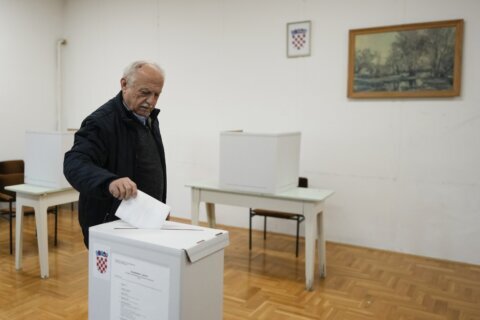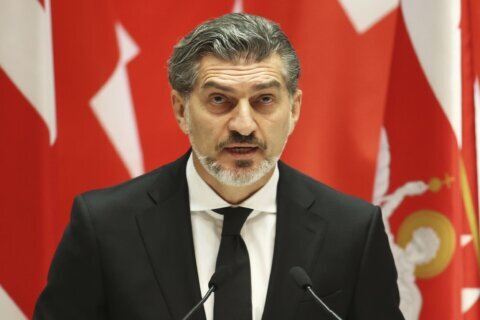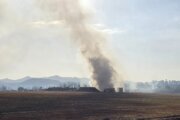BRUSSELS (AP) — President Joe Biden and his NATO counterparts are meeting in Washington this week to mark the 75th anniversary of the world’s biggest security organization just as Russia presses its advantage on the battlefield in Ukraine.
The three-day summit, which begins Tuesday, will focus on ways to reassure Ukraine of NATO’s enduring support and offer some hope to its war-weary citizens that their country might survive the biggest land conflict in Europe in decades.
Much of what NATO can do for Ukraine, and indeed for global security, is misunderstood. Often the alliance is thought of as the sum of all U.S. relations with its European partners, from imposing sanctions and other costs on Russia to sending arms and ammunition.
But as an organization, its brief is limited to the defense by military means of its 32 member countries — the sacred Three Musketeers-like vow of all for one, one for all — and a commitment to help keep the peace in Europe and North America.
That also means not being dragged into a wider war with nuclear-armed Russia. Here’s a look at NATO and how it’s aiding Ukraine:
What is NATO?
Founded in 1949, the North Atlantic Treaty Organization was formed by 12 nations to counter the threat to European security posed by the Soviet Union during the Cold War. Dealing with Moscow is in its DNA.
NATO’s ranks have grown since the Washington Treaty was signed 75 years ago — to 32 countries after Sweden joined this year, worried by an increasingly aggressive Russia.
NATO’s collective security guarantee — Article 5 of the treaty — underpins its credibility. It’s a political commitment by all member countries to come to the aid of any member whose sovereignty or territory might be under attack. Ukraine would meet those criteria, but it is only a partner, not a member.
NATO’s doors are open to any European country that wants to join and can meet the requirements and obligations. Importantly, NATO takes its decisions by consensus, so every member has a veto.
Who’s in charge?
The United States is the most powerful member. It spends much more on defense than any other ally and far outweighs its partners in terms of military muscle. So Washington drives the agenda.
NATO’s day-to-day work is led by its secretary-general — former Norwegian Prime Minister Jens Stoltenberg, until he is replaced on Oct. 1 by outgoing Dutch Prime Minister Mark Rutte.
NATO’s top civilian official chairs almost weekly meetings of ambassadors in the North Atlantic Council at its Brussels headquarters. He chairs other “NACs” at ministerial level and summits of heads of state and government. Stoltenberg runs NATO HQ. He does not order the allies around. His job is to encourage consensus and speak on behalf of all 32 members.
NATO’s military headquarters is based nearby in Mons, Belgium. It is always run by a top U.S. officer. The current supreme allied commander Europe is Army Gen. Christopher Cavoli.
What is NATO doing to help Ukraine?
Even though most allies believe that Russia could pose an existential threat to Europe, NATO itself is not arming Ukraine. As an organization, NATO possesses no weapons of any kind. Collectively, the alliance provides only non-lethal support — fuel, combat rations, medical supplies and body armor, as well as equipment to counter drones or mines.
But members do send arms on their own or in groups.
NATO is helping Ukraine’s armed forces shift from Soviet-era military doctrine to modern thinking. It’s also helping strengthen Ukraine’s defense and security institutions.
In Washington, NATO leaders will endorse a new plan to coordinate the delivery of equipment to Ukraine and training for its armed forces. The leaders will renew a vow that Ukraine will join the alliance one day, but not while it’s at war.
Why is NATO stationing more troops on its European borders?
While some allies have left open the possibility of sending military personnel to Ukraine, NATO itself has no plans to do this.
But a key part of the commitment for allies to defend one another is to deter Russian President Vladimir Putin, or any other adversary, from launching an attack in the first place. Finland and Sweden joined NATO recently over concern about this.
With the war in its third year, NATO now has 500,000 military personnel on high readiness to counter any attack, whether it be on land, at sea, by air or in cyberspace.
The alliance has doubled the number of battle groups along its eastern flank, bordering Russia and Ukraine. Allies are almost continuously conducting military exercises. One of them this year, Steadfast Defender, involved around 90,000 troops operating across Europe.
Isn’t the U.S. doing the heavy lifting?
Due to high U.S. defense spending over many years, America’s armed forces benefit not only from greater troop numbers and superior weapons but also from significant transport and logistics assets.
Other allies are starting to spend more though. After years of cuts, NATO members committed to ramp up their national defense budgets in 2014 when Russia annexed Ukraine’s Crimean Peninsula.
The aim was for each ally to be spending 2% of gross domestic product on defense within a decade. A year ago, with no end to the war in sight, they agreed to make 2% a spending floor, rather than a ceiling.
A record 23 countries are expected to be close to the spending target this year, up from only three a decade ago.
Copyright © 2024 The Associated Press. All rights reserved. This material may not be published, broadcast, written or redistributed.







